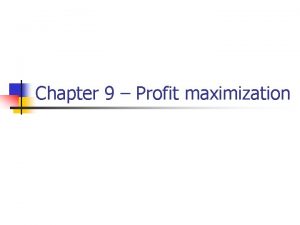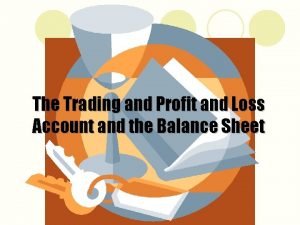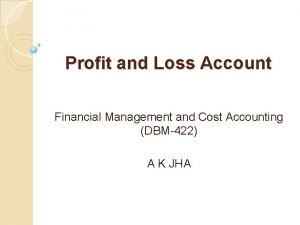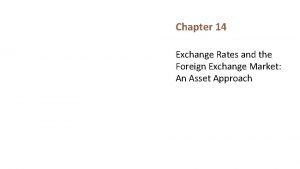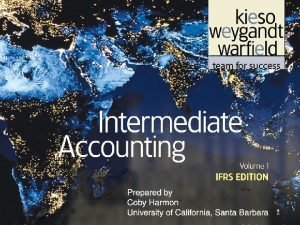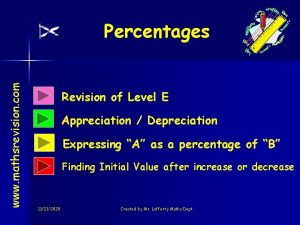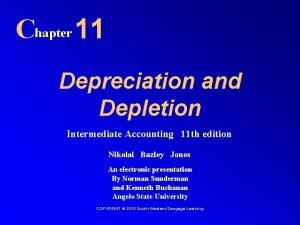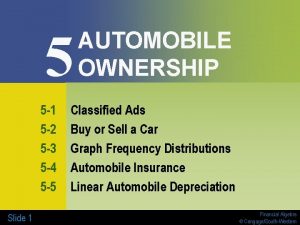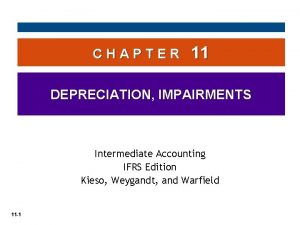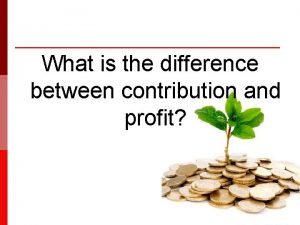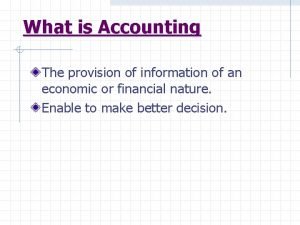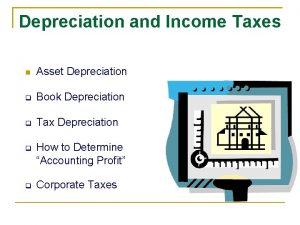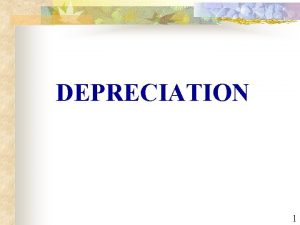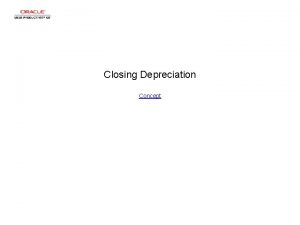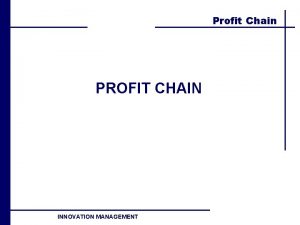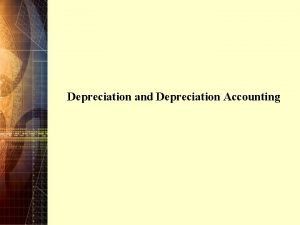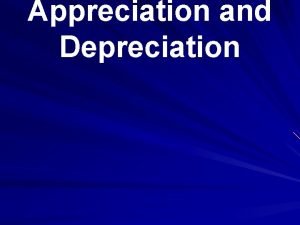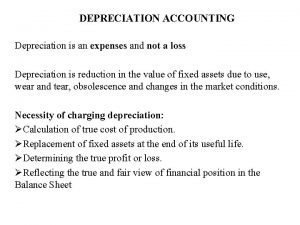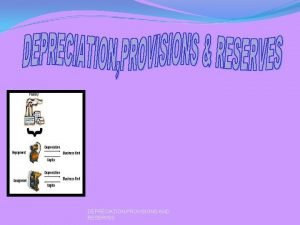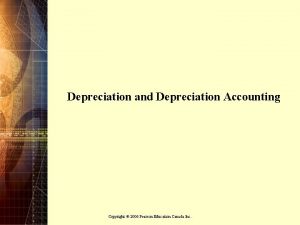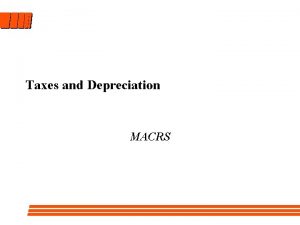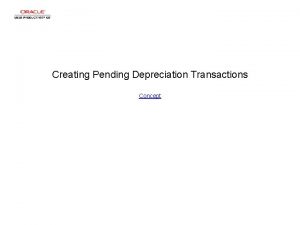PROFIT AND GAINSII DEPRECIATION INTRODUCTION Depreciation is a














- Slides: 14

PROFIT AND GAINS-II DEPRECIATION

INTRODUCTION Depreciation is a very important item treated under the head Profit & Gains of business. In simple language depreciation is decrease in the value of an asset due to its wear and tear and passage of time. The income tax 1961 defines depreciation as “ Depreciation is the process of allocating the cost of long-term asset to the time periods in which it is used in a systematic and rational manner. As time passes the value of a capital assets goes on decreasing and deprecation measure this decrease in monetary value which in turn is treated as business expenditure and debited to profit and loss account of the assessee”

• DEPRECATION IS CALCULATED WITH FOLLOWING THREE OBJECTS: A. To arrive at the real business profits by charging the monetary value of decrease in efficiency of any asset used for the business. B. To determine the book value of asset at any given time so as to assess the net worth of the business. C. To know the real position about the asset and to arrange for its replacement or renewal by setting aside a specified sum out of each year’s profits.

CHARGE OF DEPRECIATION A. Profits & gains of business or profession carried on by the assesses during relevant previous year; or B. Income from other sources in case of assets let out for a certain period of time and letting is not the regular business of assesses.

TANGIBLE ASSETS A. Building : Any structure having walls and a room may be made of bricks or wood but which can be put to use is called building. It includes factory , office , go down , workshop , residential house of employees , school , hospital , crèche , club , canteen , etc. Classification of building : There are four categories 1. Building ( non-factory ) 2. Building ( factory ) 3. Building (Priority) 4. Building (Temporary structure )

B. Machinery: Next assets to be covered under the definition of capital assets is machinery. Machinery is that complex combination of mechanical parts which help in production. It is a complex system of appliances used to achieve a desired result. C. Plant : u/s 43(3) of the Income -tax Act 1961 the word plant includes ships , vehicles , scientific apparatus , technical know-how report , surgical equipment , office equipment etc. , used for the purpose of business or profession of the assesses. Sanitary and pipeline fittings of the hotel , service line and switch gears of electric supply company are also included in the definition of plant.

D. Furniture : The term furniture included all articles of convenience or decoration used with the object of furnishing or decorating some premises. The decoration articles are also included in the definition of furniture. B. INTANGIBLE ASSETS Know-how , patents , copyright , trademarks , licenses , franchises , or any other business or commercial rights.

CONDITIONS FOR DEPRECIATION 1. Depreciation is allowed only on capital assets: Depreciation is allowed only on the capital assets namely buildings , machinery , plant and furniture. Capital assets other than these shall not be eligible for depreciation. 2. Use of assets during the year : Till assessment year 1991 -92 depreciation for full year was allowed even if assets was used for one day during the relevant previous year. But the finance (no. 2) Act 1992 has inserted a proviso by which the depreciation has been restricted.

3. BLOCK OF ASSETS: Mean a group of assets falling within a class of assts comprising : a. Tangible assets being building , machinery , plant ; b. Intangible assets being know-how , patents , copyrights , trademarks , licenses , franchises or any other business or commercial rights of similar nature. KNOW-HOW*

4. Assets must be owned by the assesses : To claim depreciation it is essential that the assesses must be owner of the business. Owner is that person who can exercise the rights of owner of his own behalf and he is entitled to income from such assets. Assesses cannot claim any depreciation unless he is the owner although he might be using it. In case of hire-purchase agreements it is essential to find out the time at which ownership is transferred to buyer from seller. In case the ownership of property has not passed to the buyer , the buyer cannot charge deprecaition.

5. Assets actually used for the business in the previous year : The deduction of depreciation allowed only on those assets which are actually used in the business of the assesses in the previous year. But in case any plant , machinery etc. is kept as standby to be used in case of emergency or break down , depreciation on such assets is also assets is allowed. 6. No depreciation in the year of sale of assets : Depreciation is only a book entry which is passed on the last day of the year. If any assets are sold during the year , such assets will not be with the business , so depreciation cannot be charge on the assets which are not in existence all that time.

7. Full particulars of assets , on which depreciation is to be charged , on must be furnished to the A. O. : all the assesses who are to charged depreciation , must furnish all the particular of the assets to the concerned Assessing officer. The assesses has to fill in a form which is prescribed for this purpose. 8. Depreciation is allowed on the basis of written down value of the asset : In case of all assets , it is to be calculated on the basis of written down value of the assets. When a new assets is purchased , the cost price of same will be the written-down value of the assets in the first year. But in case of assets engaged in generation and distribution of power , the assesses can opt for straight line method (Actual cost basis ) at rates prescribed in Appendix l-A with effect from assessment year 1998 -99.

9. Meaning of word plant : Plant includes ship , vehicles , book , scientific apparatus and surgical equipment used for the purpose of the business or profession on the but does not include tea , bushes and livestock. 10. In case of succession or amalgamation : Depreciation will be calculated on plant and machinery , building or furniture for full year and shall be allocated on the basis of number of days for which assets were used by predecessor and successor or by amalgamation company and amalgamated company as the case may be.

. ………THANKYOU. . .
 Normal profit vs economic profit
Normal profit vs economic profit Economic profit vs accounting profit
Economic profit vs accounting profit Post acquisition profit is which profit
Post acquisition profit is which profit Vertical format of trading account
Vertical format of trading account Explain any five items of departmental accounting
Explain any five items of departmental accounting Errors revealed by trial balance
Errors revealed by trial balance Particulars
Particulars Appreciation and depreciation of currency
Appreciation and depreciation of currency Impairment and depreciation difference
Impairment and depreciation difference Appreciation and depreciation maths
Appreciation and depreciation maths Chapter 11 depreciation
Chapter 11 depreciation 5-6 historical and exponential depreciation answers
5-6 historical and exponential depreciation answers Chapter 11 intermediate accounting
Chapter 11 intermediate accounting What is the difference between contribution and profit
What is the difference between contribution and profit Returns outwards
Returns outwards
